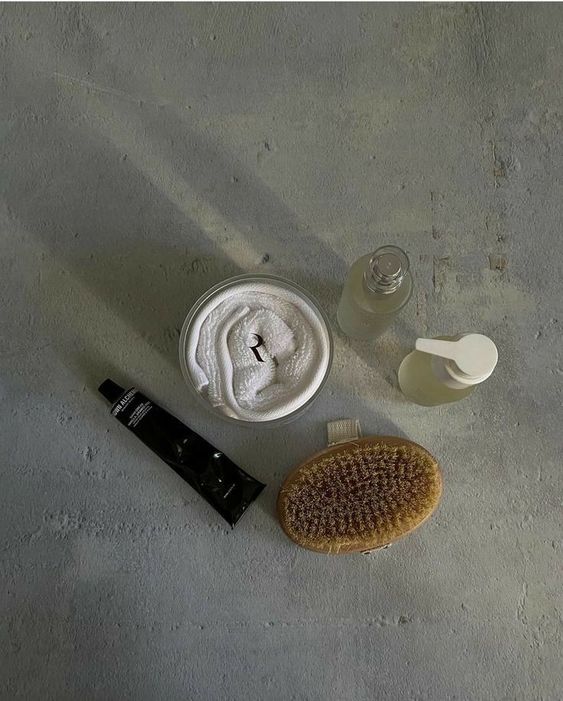Given the amount of information available today, it might seem impossible to
believe that people are still feeling confused about how to properly layer skin care products and keep their skin
in a supple state. Unfortunately, it is this informational bombardment coming from literally everywhere that is
causing so much “disorientation”.
We at Rosafa strongly advocate the idea that simplicity should be
at the cornerstone of every single
ideal skincare routine
, regardless of your skin type and needs. This concept not only will help clients easily stick to their regimen, but also minimize skin reactions and support sustainable actions. Before we actually proceed with the coveted
skincare steps order
let's do a quick recap of the different skin types and their characteristics.
Get To Know Your Skin: The Fundamentals
Normal Skin
- Uniform pink color
- Soft and velvety touch
- Fine to medium thickness
- Smooth, wrinkle-free and elastic
- Supple and toned
- Small, closed pores
- Typical of young people
- Has no blemishes, greasiness, open pores or tightness
- Well-lubricated and moisturized outer layer
- Tolerates soaps and temperature changes fairly well
- Healthy skin barrier with no disruption of the water and oil balance
Mission
- Prevent dehydration by overly cleansing, applying overly acidic formulas, over-masking, overdoing physical exfoliation
Ingredients To Look For
- Antioxidants, ceramides, honey, hyaluronic acid, niacinamide, cold-pressed vegetable oils and butters
Dry Skin
- Very thin with practically invisible pores
- Dull, matte and withered appearance.
- Rough to the touch
- Gets easily irritated and blotchy
- Tendency to wrinkle and lose elasticity
- Resists very badly the climatic changes
- Sebaceous and sweat glands are reduced in volume
- Tolerates soaps and harsh weather conditions poorly
- Rarely develops breakouts
- Sensitivity to external agents favors the appearance of cracks, flakiness and tightness
- The Natural Moisturizing Factor of the skin is compromised, leading to dehydration
- Suffers transepidermal water loss due to low secretion of occlusive oils in the skin barrier
Mission
- Strengthening the skin barrier, replenishing the lack of oils, protecting the skin, soothing the complexion, avoiding over-exfoliating and staving off aggressive ingredients (camphor, synthetic dyes, artificial fragrances)
Ingredients To Look For
- Aloe vera, arnica, berries, calendula, chamomile, ceramides, grapes, oatmeal, hyaluronic acid, turmeric, ferulic acid, phloretin, cold pressed oils (argan, evening primrose, rosehip oil, avocado oil, squalane, pomegranate, sea buckthorn), butters, niacinamide, trehalose, algae/seaweed, bakuchiol, vitamin C & E and peptides
Oily Skin
- Thick, oily and sticky to the touch
- Has a very shiny appearance with open pores
- Has overly active sebaceous glands
- Has a lower % of linoleic acid, thus becoming prone to acne and dehydration
- Greater concentration of lipids vs water components on the skin barrier
- Easily develops stubborn sebaceous plugs that clog the skin
- All forms of impurities and breakouts can be observed on its surface and deeper layers: blackheads, whiteheads, papules, pustules, and cysts
- Can develop post-acne hyperpigmentations
- Usually tolerates soaps and temperature changes well, unless it becomes dehydrated
- Keratin builds up on the outermost layer of the skin, thus promoting an oxygen deprived environment wherein bacteria can thrive and impurities get embedded
Mission
- Avoid stripping the skin of its natural oils while cleansing, balancing sebum secretion, hydrating the skin, replenishing the lack of linoleic acid and minimizing breakouts
Ingredients To Look For
- Retinoids, salicylic acid, ylang-ylang, niacinamide, benzoyl peroxide, hyaluronic acid, clays, charcoal, azelaic acid, mandelic acid, witch hazel, vitamin C, dry oils (squalane, jojoba oil, hemp oil), aloe vera, tea tree, resveratrol, turmeric and niacinamide
Combination Skin
- It is a hybrid between dry and oily skin
- The T-zone is oily and the U-zone (cheeks, sometimes the chin) dry
- The T-zone features the same characteristics as those pertaining to oily skin: shine, greasiness, breakouts, excess keratin, dehydration, uneven skin tone, etc.
- The U-zone, on the other hand, is rough, dry, dull, sensitive, blotchy, flaky, tight, with premature aging signs, etc.
- Due to the distribution of sebaceous glands, it is completely normal to have an oilier T-zone, when compared to the rest of the face. In order to qualify as combination skin, however, your T-zone should be very oily
Mission
- Cleansing without irritating, repairing the skin barrier function, normalizing sebum secretion and preventing/targeting impurities
Ingredients To Look For
- Same as those for oily (on the T-zone) and dry skin (on the U-zone) types
The Art of Layering: What You Need To Know
The word art might entail an intricate process for most people. Taking into consideration that we wave the simplicity flag, we have defined art as a “means to layer skincare products in a way that will bring about healthy skin”. Certain ingredients will be able to perform as expected regardless of order of application; however, we highly recommend the lighter-to-heavier weight technique as it is easier for everyone to remember and, overall, it also enhances the end result.
What should my morning skincare routine be like?
-
Cleanse: wipe the skin clean with a cotton pad saturated with the formula (if it is a non-rinse cleanser) or massage using a circular motion for 1 full minute and rinse thoroughly.
- Normal to dry skin types: oils, milks, creams, balms and micellar cleansers. This step is optional for these skin types.
- Combination to oily skin types: oils (made with super light-weight oils), gentle foaming and micellar cleansers.
-
Toner: it is only recommended for those who, regardless of their skin type, want to add an extra step to help finalize the cleansing process, remove embedded impurities and provide extra hydration. Dampen a cotton pad and wipe the skin after cleansing. If you need extra water, evenly distribute it on your face with your hands and penetrate with a tapping motion. Make sure the formula is alcohol-free. Aromatherapy hydrosols like aloe vera, witch hazel, lavender and rose are the optimum toning solution.
-
Serum: layer it while the skin is still damp* using an upward motion on the face, neck and décolléte. Focus on antioxidants in the morning as they are suitable for all skin types and maximize the natural protection of the skin against environmental aggressors.
-
Eye cream: tap a droplet around the eye area with the ring finger, starting at the inner corner of the lower eyelid and ending just below the start of the eyebrow. Avoid applying the cream too close to the brim of the eye as it could get inside it and cause irritation. If you bought an eye serum instead, layer it before the facial one.
-
Facial cream: apply a dime-size amount ,or a pea-size depending on the richness of the formula, using an upward motion on face, neck and décolléte and while the skin is still damp.
-
Sunscreen: wait until the moisturizer has fully absorbed and apply approximately ½ or ⅓ teaspoon of sunscreen by pressing the palms of your hands against your skin until you see no residue at all. Use a broad spectrum sunscreen with a minimum SPF 30+. Focus on mineral ingredients like non-nano zinc oxide and titanium dioxide To avoid the whitish film on the skin, use a tinted formula instead. If you live in Europe and prefer a chemical sunscreen, look for those formulated with tinosorb.
*avoid layering AHAs & BHA acids, sulfur as well as retinol while the skin is still damp because it will overly dry the skin.
What should my night skincare routine be like?
-
Cleanse: you can double cleanse at night, especially if you wore makeup during the day. You can do so by using a biphasic, micellar, or oil-based formula first, followed by a foaming, milky or creamy cleanser (depending on your skin type).
-
Toner: follow the morning instructions.
-
Serum: this is the perfect time to focus on regenerative ingredients like algae/seaweed, peptides, retinol, retinol-like actives.
-
Eye cream: do exactly the same as the morning routine.
-
Facial cream: if you must use a different formula, layer one that is a bit more nourishing and features ingredients like ceramides, omega fatty acids-rich oils and niacinamide.
-
Facial oil: normal to dry skin types benefit from adding a few drops (2-6 )of a facial oil to the moisturizer or layering it on top of it (by pressing against the skin).
What should my weekly routine be like?
Choose a time of the day where you can fully relax and get the most out of your me-time.
1. Exfoliate: apply the exfoliator after cleansing the skin. The technique entirely depends on the type of formula, some need to be massaged while others are layered as a mask that is rinsed-off-
-
Normal skin types (2-3x week): AHAs, polyhydroxy acids, gemstones and fruit enzymes
-
Combination to oily skin types (2-3x per week): BHAs, AHAs, clays and fruit enzymes.
-
Dry skin types (1-2x week): Rhassoul clay, polyhydroxy acids and fruit enzymes.
There you have it! We are confident that you now know exactly how to build an
AM and PM skincare routine
from scratch. We can't emphasize enough that the most important piece of layering advice that we can give you is to keep things simple. Refrain yourself from going overboard with the amount of products and intensity of cleansing/exfoliation. The less is more motto also applies to skincare, and it does it big time. For more information regarding your skin’s health, make sure to follow us on Instagram, Facebook, Pinterest, and Linkedin.
References
[1] https://www.jaad.org/article/S0190-9622%2886%2970025-X/fulltext




